

![[History]](home.gif) Main Page |
Main Page | ![[Photo]](profile.gif) Photo Gallery |
Photo Gallery | ![[Remember]](contents.gif) Remembrance |
Remembrance |
![[Units]](launch.gif) Units in the Northwest
Units in the Northwest
We have received many e-mails from relatives of Soldiers who fought during this eventful time in our country's history asking for information about those soldiers. We welcome any and all inquiries and will endevour to send along any information we may be able to obtain; however the information available is sketchy and incomplete.
For example, spelling of names may be wrong. Many examples only list a last name. No records we have tell of enlistment or discharge date or medals won. Many people joined units that were not in their home town or moved away after they returned from the west.
Much has been lost due to neglect and oversight and most of our information comes from Masters and Doctrinal theses as well as personal diaries. With that in mind we will answer all inquiries we receive but we ask that you be patient since it takes time to research the information.
To contact us just click on our name.

The original Midland Provisional Battalion was so named because the Companies in it were from the Midlands of Ontario. It was raised on Wednesday 1 April 1885 at Old Fort Henry in Kingston Ont and was officially disbanded at Port Hope Ontario on Wednesday 22 July 1885, having a life of only sixteen weeks.
"A", "B", "C", and "D" Companies served in General Middleton's column at the Battle of Batoche. "E", "F", "G", and "H" Companies provided garrison duty in the NorthWest Supply Depot at Swift Current under General J.W. Laurie in addition to building and piloting barges to carry supplies down river to the Forward Supply Depot at Clark's Crossing. They also provided garrison duty at the Forward Supply Depot at Clark's Crossing
All Companies were at Ft. Pitt during the Pursuit of Mistahimaskwa (Big Bear)
The Midland Provisional Battalion consisted of eight companies from different Battalions:
"A" Co. from the 15th Battalion, Argyll Light Infantry, Bellevile Ont.
"B" Co. from the 40th Northumberland Battalion, Cobourg Ont.
"C" Co. from the 45th West Durham Battalion, Lindsay Ont.
"D" and "E" Co. from the 46th East Durham Battalion, Port Hope Ont.
"F" Co. from the 47th Frontinac Battalion, Portsmouth Ont.
"G" Co. from the 57th Battalion, Peterborough Rangers, Peterborough Ont. and
"H" Co.from the 49th Battalion Hastings Rifles, Hastings County, (Belleville} Ont.

The Battalion left Fort Henry for the North-West Territories at 0800 hrs on 6 April 1885 and crossed the five breaks in the C.P.R. tracks north of Lake Superior, in temperatures reaching as low as -32 degrees F.(-35 c), from 7 April to 8 April, arriving in the village of Swift Current N.W.T. and disembarking on 10 April 1885. "A" through "D" Companies marched north to Saskatchewan Landing on 22 April where they embarked on the Steamer "Northcote" for the trip down the river. They passed through Saskatoon on 4 May and met up with elements of Middleton's column at Clarke's Crossing on 5 May.

Here, much to their disappountment,"B" and "D" Companies dismbarked to form a guard for the supply base. "A" and "C" Companies with Lt. Col. Arthur Williams, the nominal Commanding Officer of the Midland Provisional Battalion, Commanding Officer of the 46th Battalion East Durham Regiment, and M.P. for East Durham, proceeded to Fish Creek and Joined General Middleton as He prepared to move forward to Batoche on 7 May.
"E", "F", "G", and "H" Companies were seconded along with the Halifax Provisional Battalion to General Laurie's Supply Depot at Swift Current to supply garrison troops to guard the supply base. They also built and piloted a number of supply scows which brought supplies down to General Middleton's Supply Depot at Clark's Crossing. Then with the rest of the Battalion to Fort Pitt to assist General Middleton in His search for Mistahimaskwa (Big Bear).
On 9 May 1885, the first day of the battle for Batoche, Thirty-five members of the "C" Co. Infantry School, board the Hudson's Bay Co. steamer "Northcote" at Gabriel's Crossing south of Batoche in an attempt to outflank the Metis positions at Batoche. The Metis lower the ferry cable at Batoche to prevent the "Northcote" from steaming down river and outflanking them. This results in the cable shearing the funnels and the masts off the steamer which causes the draft through the boilers to cease resulting in a loss of steam pressure to the paddlewheels which causes the Northcote to flounder helplessly down river. The American Captain of the Steamer refuses to go back to Batoche and instead goes to Hudson's Bay Landing for repairs.This effectively prevents the soldiers on board from forming a two-pronged attack on the Metis.
This event was, and remains to this day, the only Naval engagement in Saskatchewan history.
The Midland Battalion ended up holding the left flank of the battlefield facing the Metis. On the morning of 12 May 1885 General Middleton led a feint on the Metis left flank, (the battalion's right flank), using the Gatling gun as bait. The idea was to draw the Metis away from the town of Batoche leaving a gap which the army would exploite and capture the town. General Middleton tried to signal by Cannon fire for the Battalion center and left flanks to attack but the wind was blowing in the wrong direction and the signal was never heard.
Although the attack never took place that morning it did do what General Middleton wanted which was to draw the Metis from the left flank
In the afternoon Lt.Col. Williams realized the Metis were almost out of ammunition and powder. so He organized a charge of the Metis positions. This charge routed the Metis and ended the battle.
An interesting thing about the charge was that General Middleton was having His lunch when the attack started. Since He had not yet ordered an attack for the afternoon He tried to have Lt.Col. Williams court-martialled for disobeying orders. This, however, was quashed.
The Battalion had their final mustering out parade on 1 July 1885 at Fort Pitt. Lt.Col. Williams died on 4 July of, "Brain fever," (Most likely Typhoid Fever), on the Hudson's Bay Company steamer "NorthWest" on the way back to Fort Battleford.
On 21 July the Battalion carried out their last official act which was the military funeral of Lt.Col. Williams in Port Hope Ont. On 22 July 1885 the Battalion was paid off and officially disbanded.
When the Battalion was getting ready to return home many single members expressed interest in settling in the west. The government, still nervous that hostilities might break out again, readily agreed to offer each soldier 160 acres of free land under the Dominion Lands Act of 1871 if they stayed. As a result, the area between Duck Lake and Prince Albert was settled by many members of the battalion. Many of their families still live there today.
The eight Regiments that formed the Midland Provisional Battalion eventually were amalgamated together in the intervening years to became the Hastings and Prince Edward Regiment with Headquarters in Belleville Ontario.
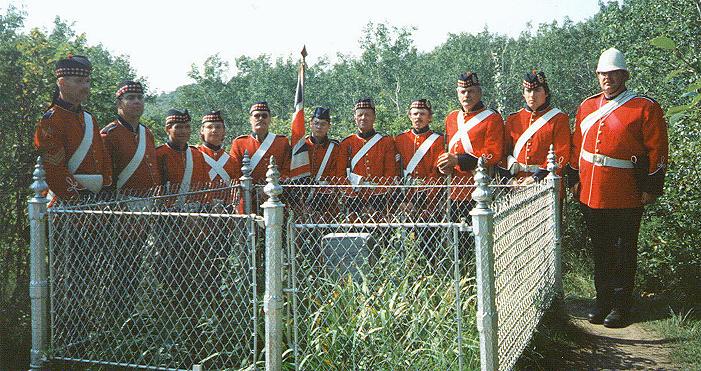
In the early 1880's almost everyone living in the Northwest Territories had grievances against the Government of Canada. The native people had signed treaties which were supposed to compensate them for giving up claim to the whole of the territory and agreeing to settle on reserves and learn white-style agriculture. But the Government was reluctant to live up to its side of the bargain and tried to evade its responsibilities. Thus, people who were already unhappy at having to give up much of their traditional way of life were made more angry and desperate as the promised new way of life failed to materialise.
The white settlers in the Territory were also angry and aggrieved. They accused the Canadian Government of operating the Territory solely for the benefit of Eastern Canadian business to the detriment of local interests. One complaint was that the Government insisted the settlers "prove" their land which is to homestead for five years, break, and cultivate 60 acres of land. Since many of the settlers had lived there for ten or more years and had broken and cultivated their entire 160 acres they felt the Government was being unreasonable. Another complaint was the political appointments for civil servants from outside the territory and the lack of political representation.
Although their actions at Red River in 1869/70 had won some major concessions from Ottawa, many of the Metis had moved farther west and settled in the Saskatchewan Territories at the site of Batoche's ferry crossing across the South Saskatchewan River. By the 1880's, settlers from Europe and Eastern North America were moving into southern Saskatchewan and the Metis saw their traditional lifestyle threatened again.
By the middle of the decade all parties in the west were holding meetings, sending petitions and discussing political tactics for redress of their grievances against a government which seemed as uninterested as it was remote.
This timeline cannot cover every event that happened that fateful year since so much happened. Only the major events and people involved are recorded here as well as what subsequently happened to them.
Saturday 10 May 1884
The Prince Albert Times newspaper in a biting editorial taunts the Dominion Government labelling it, "a greedy, grasping, overbearing bully", and concludes on this note, "Where they get the information which induces them to believe the people are likely to submit much longer, we do not know; but we can answer them that they need not look for their friends among the Canadians, half breeds, or Indians, as they are likely soon to be made aware of in a manner at once startling and unpleasant." The editorial is translated into French and circulated among the Metis in that area.
Saturday 24 May 1884
A protest meeting is held in the Lindsay School House near Prince Albert. Whites, English speaking half-breeds, and French speaking Metis pass resolutions similar to those passed at other protest meetings. The discussion centers around the advisability of consulting Louis Riel. Over the protests of some of the English speaking half breeds the meeting finally adopts a resolution favouring the sending of a delegation to Riel to seek his assistance in presenting the resolutions passed earlier in the meeting to the Government
Thursday 5 June 1884
James Isbister, a Scot and three Metis; Michel Dumas, Moyes Ouellette, and Gabriel Dumont, ride to St. Peter's mission in Montana to try and persuade Louis Riel to once again bargain with the Canadian Government to protect the rights of both Metis and white settlers. After two days Riel decides to go with them to Batoche

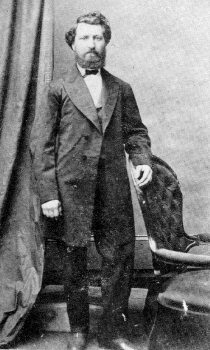
Tuesday 8 July 1884
Riel arrives in Duck Lake 20 kms. west of Batoche
Thursday 19 July 1884
Following insistant requests from a group in Prince Albert, Louis Riel speaks to a well attended meeting. Here He repeats the constitutional nature and aims of the agitation for responsible government in the Northwest. White settlers, including spokesmen of the newly formed Settlers Union, endorse the proposals. At the end of the meeting, after a question period, the gathering seems convinced that He is opposed to violence.
Tuesday 16 December 1884
Riel sends a list of demands to Ottawa
Wednesday 28 January 1885
The Canadian Government ,in council, agrees to form a commission to investigate Metis grievances in Manitoba and the Northwest Territories.
Thursday 5 March
Louis Riel and a group of prominent Metis hold a secret meeting. They sign an oath to "save our country from a wicked government by taking up arms if necessary."
Tuesday 10 March
White settlers who originally had been with the Metis cause pull out stating in writing to Riel, "We will have nothing whatsoever to do with any appeal to arms."
Friday 13 March
N.W.M.P. Superintendent Lief Crosier telegraphs from Fort Carlton to Ottawa regarding the worsening situation at Batoche. "Half-breed rebellion liable to break out at any moment. If half-breeds rise Indians will join them."
Sunday 15 March
Louis Riel speaks to an assembly of Indian Chiefs and scores a decisive coup when he uses a partial eclipse of the sun as a sign of, "Big Medicine."
Wednesday 18 March
Riel's followers cut the telegraph wires at Batoche, ransacks Government stores and seizes employees as hostages. Riel proclaims a provisional government with himself as president and Gabriel Dumont as adjutant general. Commissioner Acheson Gosford Irvine leaves Regina for Prince Albert with 90 N.W.M.P., 66 horses, and a long train of sleighs leaving behind a skeleton staff of only 32 men and no horses to cover the rest of the territory.
Thursday 19 March
Louis Riel attends a religious feast at Batoche for the Roman Catholic patron saint of the Metis, St. Joseph. Taking advantage of the large gathering Riel exploits the rumour that a strong body of Mounted Police are on their way to attack the Metis. Louis Riel then forms the ministry and the army of the Provisional Government of Saskatchewan.
Saturday 21 March
Riel sends a message to Superintendent Lief Crosier and demands the surrender of the N.W.M.P. detachment at Fort Carlton threatening, "To commence without a delay a war of extermination upon those who have shown themselves hostile to our rights."
Sunday 22 March
The Winnipeg Militia is ordered to a state of readiness and 60-Year-old Major-General Frederick Dobson Middleton British Commander of the Canadian Militia is given command of the troops. English Half-Breeds in the territory vote to remain neutral in the event of armed conflict.
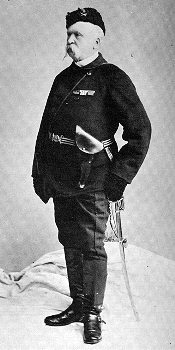
Monday 23 March 1885
Prime Minister Sir John A. McDonald, prompted by an urgent telegram from Northwest Territories Lieutenant-Governor Edgar Dewdney, orders mobilization of troops in every province of Canada. General Middleton, is given orders to march west with all due speed.
Thursday 26 March
At 2:30 a.m. Commissioner A. G. Irvine sets out from Prince Albert for Fort Carlton with 83 police and 25 civilian volunteers to bolster the defenses. Before the Relief column from Prince Albert arrives, Superintendent Lief Crozier leads 55 N.W.M.P. and 43 P.A. volunteers from Fort Carlton and engages the Metis under the command of Gabriel Dumont one-mile west of Duck Lake. The first shot is purportely fired by "Gentleman" Jim McKay; a N.W.M.P. scout
from the Duck Lake district. 9 P.A. Volunteers and 1 N.W.M.P. are killed and 12 are wounded. 4 Metis and 1 Indian are killed and 3 are wounded. Crozier is wounded receiving a flesh wound to the right cheek. Gabriel Dumont has a bullet graze his scalp. Louis Riel, observing the battle, orders Gabriel Dumont not to allow the victorious Metis and Indians to pursue the retreating Police and Militia. One hour after Crozier limps back to Fort Carlton Commissioner Irvine's column arrives from P.A.
Friday 27 March
General Middleton arrives in Winnipeg and leaves that night with 260 officers and men of the 90th Winnipeg Rifles (The Little Black Devils). Two more N.W.M.P. constables die from wounds received at Duck Lake and the three Constables are buried at Fort Carlton. Commissioner Irvine decides to abandon Fort Carlton and retreat to P.A. the next day due to the Fort's poor defensibility and location.
Saturday 28 March
Fort Carlton is abandoned. A fire breaks out in the hospital during the pullout, which spreads to engulf the entire fort burning it to the ground. The survivors march unmolested back to Prince Albert.
Saturday 28 March
News of the fight at Duck Lake hits Eastern Canada. The Federal Government begins raising
a Canadian Militia Force. Within two weeks, three columns of the Northwest Field Force are in motion.
Sunday 29 March
When news of the Metis success at Duck Lake reaches the Poundmaker
reserve Pitikwahanapiwiyin decides to utilize the unrest and fears of government agents to negotiate necessary supplies. Joined by the Stonies, the Cree go to Battleford.
Monday 30 March
Pitikwahanapiwiyin and his people found the town deserted. Efforts to open negotiations with Indian Agent
Rae fail when the Indian Agent refuses to meet with him. Hungry and frustrated, some of Cree and Stonies began looting the empty homes in the Battleford area, despite Pitikwahanapiwiyin's attempts to stop them. The Canadian Government appoints a parliamentary committee to investigate Metis claims and petitions.
Tuesday 31 March
The Council of the Provisional Government of Saskatchewan moves the Metis force to Batoche. They
construct a defensive system of trenches and rifle pits around Batoche. The combined Battleford bands move west to the Poundmaker reserve and establish a large camp east of Cutknife Creek. Though Pitikwahanapiwiyin is appointed the political leader and chief spokesperson for the combined bands, a soldiers' lodge is also erected at the Cutknife
camp. According to Plains Cree tradition, once erected the soldier's lodge, not the chief, is in control
of the camp. Itka kills farm instructor Payne on the Mosquito reserve.
Wednesday 1 April
The Midland Provisional Battalion is raised in old Fort Henry in Kingston Ont. The nominal Commanding Officer appointed is Lt. Col. Arthur T. H. Williams, Member of Parliament for Port Hope and the Commanding Officer of the 46th East Durham Regiment.
Thursday 2 April
Kapapamahchakwew (Wandering Spirit), the War Chief of Mistahimaskwa's, (Big Bear's), band shoots Thomas Quinn the Indian agent and calls on the rest of his band to kill the other whites. At the end of the shooting Quinn, two Catholic priests, five other whites, and a Metis are murdered. This event will become known as the Frog Lake Massacre. General Middleton arrives at Fort Qu'appelle with the 90th Winnipeg Rifles. They will spend the next four days in rifle practice, as many of them had never fired a weapon before.
Monday 6 April
The Midland Provisional Battalion entrains for the West. General Middleton's column heads north for Batoche with 800 men. The nights are so cold that in the mornings the tent pegs have to be chopped out of the ground by axes. The days so cold that those lucky enough to be mounted will find their boots freeze to the stirrups.
Friday 10 April
Midland Provisional Battalion detrains at Swift Current and goes under canvas.
Monday 13 April
Mistahimaskwa, (Big Bear,) and 250 mounted Indians surround Fort Pitt and demand the surrender of the Fort and the inhabitants. They also ask for tea, tobacco, and blankets. N.W.M.P. Officer in charge of the fort, Inspector Francis Jeffrey Dickens, son of English novelist Charles Dickens, acts so confused and excited that the civilians decide to go to the Indian camp as hostages rather than take their chances with the Mounted Police. Later that night the N.W.M.P. abandon Fort Pitt and cross the N. Saskatchewan River. A relief column of Militia including "E" Coy the 46th East Durham Battalion, Port Hope Ont. and "F" Coy. the 47th Frontinac Battalion, Portsmouth Ont. of the Midland Provisional Battalion heads north from Swift Current to Ft. Battleford led by Lt.Col. William Otter. A detachment of N.W.M.P. under Superintendent William Herchmer acts as scouts.

Tuesday 14 April
Inspector Dickens and his men start their journey down the river to Fort Battleford in a leaky boat.
Wednesday 15 April
Const David Cowan aged 18 is killed by Poundmaker's warriors while trying to ride through their camp on the way back to Fort Pitt from a scouting mission. He was unaware that the rest of the detachment has left the day before.
Thursday 16 April
Two messengers from General Middleton arrive in Prince Albert and inform N.W.M.P. Commissioner Acheson Gosford Irvine of General Middleton's plans for attacking Batoche on 18 April.
Friday 17 April
General Middleton's column reaches Clarke's Crossing and General Middleton unwisely splits his force in two columns in order to cover both the east and west banks of the South Saskatchewan River.
Sunday 19 April
Commissioner Irvine with 200 mounted men march towards Batoche but turn back when scouts report that General Middleton had not yet attacked Batoche.
Monday 20 April
General Thomas Bland Strange ("Gunner Jingo") leads his column north from Calgary 200 miles to Edmonton.

Wednesday 22 April
Dickens's party reaches Fort Battleford to find the Indians from Poundmaker's reserve have become bored with the siege and returned to the reserve. Inspector Dickens refuses to assume command of the Fort even though He outranks Inspector Morris the Fort's commander.
Thursday 23 Aprl
The Steamer Northcote leaves Saskatchewan Landing north of Swift Current carrying food, hay, oats, part of a field hospital, a Gatling Gun, and "A" Coy. through "D" Coy. heading down river for Clarke's Crossing.
Friday 24 April
A force of 150 Metis under Gabriel Dumont ambushes General Middleton's east bank column at Fish Creek. The Metis break off the fight when their ammunition runs out suffering four wounded. This keeps Middleton from being defeated. Middleton loses 10 killed and 43 wounded which is almost ten percent of His East Bank force and is almost a casualty himself when his fir cap is shot off his head and a bullet grazes his horse. General Middleton's west bank column finds a scow and attempts to cross the river to the east bank but before the first load of soldiers can get across the battle is over. General Middleton declares Fish Creek a victory. Middleton then decides to wait at Fish Creek for re-enforcements to catch up before advancing on Batoche. Fort Battleford is relieved by the column from Swift Current when Lt.Col. Otter marches into Fort Battleford unopposed.
Friday 1 May
Col. Otter leads an expedition from Battleford to Pitikwahanapiwiyin's, (Poundmaker's) Reserve. General Strange's column reaches Edmonton.
Saturday 2 May
After seven hours of fighting, Col. Otter's force is badly mauled at Cut Knife Hill by Pitikwahanapiwiyin's, (Poundmaker's) Crees and is forced to withdraw back to Battleford. At this point Pitikwahanapiwiyin, (Poundmaker )
steps in and stops the Indians from attacking the retreating troops. Following the battle, Pitikwahanapiwiyin attempts to move the camp to the hilly country around Devil's Lake. The warriors leading the camp, however, prevent this retreat and begin leading the combined tribes east to join Riel at Batoche.
Tuesday 5 May
Lt.Col. Williams, "A" Co. 15th Argyl Light Infantry, Bellevile Ont., and "C" Co. 45th East Durham Regiment, Lindsay Ont. of the Midland Provisional Battalion meet Boulton's Mounted Infantry of General Middleton's column at Clarke's Crossing and proceed north to the Fish Creek camp. "B" Co. the 40th Northumberland Regiment, Cobourg Ont. and "D" Co. the 46th East Durham Regiment, Port Hope Ont. cross the river to the west bank to protect Middleton's column from attack by Metis and Native forces from the Duck Lake area.
Thursday 7 May
Almost two weeks after the Battle of Fish Creek and almost three weeks after the date he had given Supt. Irvine General Middleton leaves Fish Creek and marches on Batoche with 850 men, four nine pounder cannon, the Gatling gun which was in charge of Captain Arthur N. Howard of the Connecticut National Guard, and fifty wagons.

Saturday 9 May
Thirty-five members of the "C" Co. Infantry School, board the Hudson's Bay Co. steamer "Northcote" at Gabriel's Crossing south of Batoche. The Metis lower the ferry cable at Batoche's Crossing shearing the funnels and the masts off the steamer. This causes a loss of draft through the boilers resulting in a loss of motive power and subsequent loss of steering. The Northcote drifts downstream until later that night when the damage is repaired.

In the afternoon Middleton orders a "Zareba" built which is a round defensible position dug into the ground and surrounded by meal bags and wagons. This is done in M. Jean Caron Sr.'s potato field just east of his residence.

Gunner William Phillips from "A" Battery, Artillery School, R.C.A. is killed in the afternoon. Since he is an orphan and has no one to claim his body, he will be buried on the riverbank next to the battlefield and becomes the only soldier buried at Batoche.

Monday 11May
Middleton leads a group to the Jolie Prairie to see the spot and is pleased at it's location as a jumping off place for an attack on Batoche. When the Metis learn of his presence there they suspect an attack from that direction and hurry to reinforce the rifle pits on the north and east of the village. Middleton then orders all remaining troops in the Northwest to Batoche. The Northcote finally lands at Hudson's Bay Landing south of Prince Albert for repairs and fuel before heading back upriver to Batoche.
Tuesday 12 May
In the morning General Middleton leads a feint on the Metis left flank which is partially successful, In the afternoon Lt.Col. Williams, irked by the slow progress and by rumours that British regulars were to be called in, organizes a charge of the Metis positions that routs the Metis and ends the battle. The soldiers start looting the town and in the confusion Louis Riel and Gabriel Dumont flee. The Northcote with her load of soldiers finally gets to Batoche a half-hour after the fighting is over
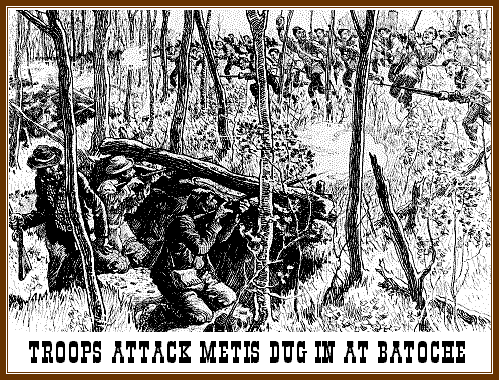
Thursday 14 May
While passing through the Eagle Hills, Pitikwahanapiwiyin's, (Poundmaker's) bands capture a wagon train carrying supplies for Colonel Otter's column. Once again Pitikwahanapiwiyin, (Poundmaker) successfully intervenes to prevent bloodshed and the twenty-one teamsters captured along with the wagons are taken prisoner. Const. Frank Elliot is killed while on Patrol near Battleford.
Friday 15 May
Metis Leader Louis Riel gives himself up to Privates. Armstrong and Hourie of Boulton's Mounted Infantry and is brought back to camp where he is formally arrested by General Middleton. Metis General Gabriel Dumont escapes to Montana
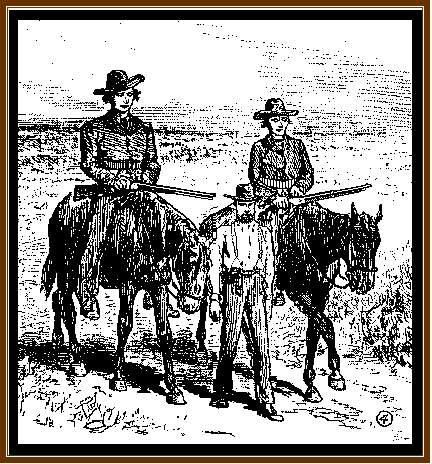
Monday 18 May
Louis Riel is transported to Regina for trial under escort from the 90th Winnipeg Rifles (nicknamed "The Little Black Devils").
Tuesday 19 May
Pitikwahanapiwiyin's, (Poundmaker's) bands learn of the Metis' defeat at Batoche. Regaining control of the combined
bands, Pitikwahanapiwiyin sends Father Louis Cochin to Major-General Frederick Middleton asking for his peace terms.
Monday 25 May
Chief Pitikwahanapiwiyin, (Poundmaker) surrenders his arms and his followers at Fort Battleford to Middleton. He is immediately imprisoned.
Tuesday 26 May
General Thomas Bland Strange, ("Gunner Jingo"), and his men of the Alberta Field Force led by Supt. Sam Steele arrive at Fort Pitt to discover the body of eighteen year old Constable David Cowan, a Police Scout who had been killed on 14 April while trying to ride through Big Bear's camp after the Frog Lake massacre.
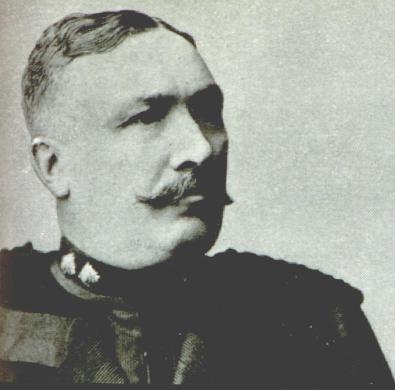
Wednesday 27 May
General Thomas Bland Strange, ("Gunner Jingo"), and his men of the Alberta Field Force leave Fort Pitt for Frenchman's Butte and prepare to fight Mistahimaskwa, (Big Bear,) and his warriors.
Thursday 28 May
Battle of Frenchman's Butte. General Strange forces Mistahimaskwa, (Big Bear,) and his men to retreat north.
Wednesday 3 June
The Battle of Steele Narrows. The last battle on Canadian soil. A detachment of N.W.M.P. under Supt. Samuel Steele fights with Crees under Mistahimaskwa, (Big Bear,) but the Cree chief escapes.
Wednesday 1 July Dominion Day
The Midland Provisional Battalion has their final mustering out parade at Ft. Pitt, N.W.T. For the first time the entire North-West Field Force consisting of General Middleton's column, Colonel Otter's column, General Strange's column, and almost the entire N.W.M.P. force are in attendance. For this one day the swelled ranks of soldiers on parade make Fort Pitt the largest settlement west of Winnipeg.
Thursday 2 July
Mistahimaskwa, (Big Bear,) accompanied by his son, "Horse Child," and a councillor, "All And a Half," surrenders at Fort Carlton to N.W.M.P. Sgt. Smart after evading soldiers and the N.W.M.P. for two hundred miles. The North-West Field Force begins breaking camp in preparation for the steamer trip back east.
Saturday 4 July
Lt.Col. Williams dies of Typhoid Fever on the Hudson's Bay Company steamer "Northwest" on the way back to Fort Battleford.
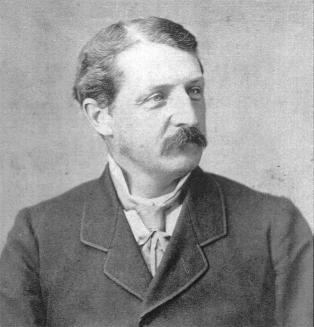
Monday 6 July
Riel is formally charged with high treason.
Monday 20 July
The trial of Louis Riel begins in Regina in a rented room as the Court House is too small for the number of spectators and press. Mr. Justice Hugh Richardson presides.
Tuesday 21 July
Military funeral of Lt.Col. Williams in Port Hope Ont.
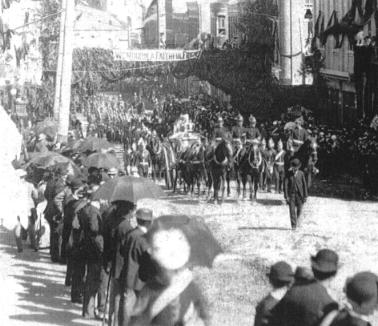
Wednesday 22 July
The Midland Provisional Battalion is paid off and officially disbanded.
Monday 29 July
Louis Riel's lawyers want him to plead insanity but Riel refuses, believing that if he does the Metis cause will not be taken seriously.
Saturday 1 August
Louis Riel is found guilty of treason but the all white jury recommends clemency. Justice Hugh Richardson reluctantly sentences Riel to be executed by hanging on 21 September.
Wednesday 5 August
Sir John A. McDonald requests that murder charges be laid against the Indians involved at Frog Lake and in the killing of Payne.
Thursday 13 August
Kapeyakwaskonam (One Arrow) tried on the charge of treason-felony,
found guilty and sentenced to three years imprisonment .
Friday 14 August
A number of Metis involved in the rebellion plead guilty to treason-felony and receive prison
sentences ranging from one to seven years.
Monday 17 August
Pitikwahanapiwiyin's, (Poundmaker's) trial on the charge of treason-felony began in Regina before Judge Richardson. Regarded as second in importance only to Riel's, the trial lasts for two days. After deliberating for half an hour, the jury returns a guilty verdict. Pitikwahanapiwiyin, (Poundmaker) is sentenced to three years in the Stony Mountain Penitentiary in Manitoba.
Wednesday 9 September
Friday 11 September
After deliberating for fifteen minutes, the jury finds Mistahimaskwa, (Big Bear,) guilty of treason-felony, and he is sentenced to three years at the Stony Mountain Penitentiary in Manitoba.
Friday 25 September
Kapapamahchakwew (Wandering Spirit) is tried at Battleford and
sentenced to hang for starting the Frog Lake Massacre.
Monday 5 October
Itka and Man Without Blood are tried, found guilty and sentenced to
hang for killing Payne.
Saturday 10 October
Five Indians are tried in Battleford for involvement at Frog Lake, are found guilty and sentenced to hang.
Thursday 22 October
Judicial Committee of the Privy Council rules against Riel's appeal.
Monday 9 November
A stay of execution is granted to allow three Physicians; Drs. Augustus Jukes, F.X. Valade and M. Lavell, to re-assess Riel's mental condition. This Medical commission submits its report to the Prime Minister. The Commission is divided on the question of Riel's sanity. Cabinet decides to proceed with the death penalty.
Monday 16 November
Louis Riel is executed by hanging at the Mounted Police Barracks in Regina. "Entrepreneurs" sell foot long lengths of "The rope that hanged Riel" and sell 2,000 pounds of rope.
Tuesday 17 November
A rumour is started that N.W.M.P. officers had kicked Riel's body in the face before placing him in a coffin. The furor caused by the Catholic Church is so great that the coffin is opened and Dr. Augustus Jukes examines Riel's body. No evidence of abuse is found.
Friday 20 November
Louis Riel is laid to rest in the cemetery of the Cathedral of St. Boniface in Winnipeg.
Friday 27 November
Kapapamahchakwew (Wandering Spirit) and 7 other Indians are hanged in Fort Battleford for the Frog Lake Massacre and are buried in a common grave outside the Fort gates.

In the aftermath of the Rebellion few of the principles escaped some kind of notoriety. For some, the rebellion made their reputations; For others, the rebellion ruined theirs.
Once the final tally is in it is discovered that the Canadian Government spent five million dollars putting down the rebellion.
Gabriel Dumont escapes south through the Cyprus hills into the United States despite being sought by the Army and N.W.M.P. He is taken prisoner by the U.S. Army and held for three months at Fort Assiniboia in Montana. In February of 1886 Gabriel Dumont accepts an offer to demonstrate his marksmanship skills by performing in Buffalo Bill Cody's Wild West Show. On Tuesday 19 February 1889 The Canadian Government pardons Gabriel Dumont for his part in the NorthWest rebellion. After visits to Quebec where he dictates his memoires, Gabriel Dumont returns to his old homestead at Gabriel's Crossing south of Batoche. He lives there quietly until his death in 1906.
Pitikwahanapiwiyin, (Poundmaker) serves only one year in Stony Mountain Penitentiary before being released in October 1886 because of poor health (He had tuberculosis). Four months later, while visiting his adopted father Isapo-Muxika on the Blackfoot reserve, he suffers a lung haemorrhage and dies.
Released from Stony Mountain Penitentiary in February 1887 because of poor health, Mistahimaskwa, (Big Bear,) settles on the Poundmaker reserve where he dies on 17 January 1888 and is buried there.
Shortly after the Rebellion's end a grateful Canadian Government votes Maj. General Frederick Dobson Middleton a gift of $20,000.00 and he is made a Knight Commander of the Order of St. Michael and St. George. On Monday 12 February 1890 Maj. General Sir Frederick Dobson Middleton is criticized by a select committee of the House of Commons for the, "misappropriation," of furs , (valued at approximately $50,000.00 in 1885,) from a Metis named Charles Bremner after the rebellion. On Tuesday 24 June 1890, still smarting from the parliamentary criticism, General Middleton resigns from the Canadian Militia. He returns to England where he is appointed keeper of the crown jewels in 1896. He dies on 25 January, 1898.
In 1886 Supt. Samuel Benfield Steele is posted to Fort McLeod in the Alberta district of the North-West territories. In August of 1887 Supt. Steele leads his men of the "D" Division to a spot at the junction of the Kootenay River and Wild Horse Creek in British Columbia and builds a fort aptly named, "Fort Steele." Accomplishing his mission Supt. Steele and the men of "D" Division abandon Fort Steele in August of 1888 and ride eastward back to Fort McLeod. On 29 January 1898 Steele is ordered to the Yukon and sets up a Division office in Dawson City. On 1 September 1898 he is appointed Officer Commanding of the Mounted Police in the Yukon. In September 1899 Supt. Steele is ordered back to the North-West Territories. In 1899 he takes command of the Lord Strathcona Horse and takes it to South Africa to fight in the Boer War. After the Boer War he stays in South Africa until 1906 to organise the South African Constabulary. On his return to Canada he is appointed to the permanent staff of the Canadian Army. When the First World War breaks out he is promoted to Major-General and leads the Canadian Second Division to England. He is knighted in 1918 and retires that year after more than fifty years distinguished police and military service and dies at the age of sixty-eight years on 30 January 1919. He is buried in St. John's Cemetery in Winnipeg.
Lt.Col William Dillon Otter's military reputation was not harmed by his loss at Cut Knife Hill. He will serve in the Boer War and become the first Canadian-born Chief of the General Staff. During the First World War he is placed in charge of Canadian internment camps. He is knighted in 1913 and made a general in 1923.
Commissioner Acheson Gosford Irvine is publicly censured by General Middleton for not attacking Batoche. In March 1886 he "resigns" from the force and becomes an Indian Agent on the Blood Reserve. In 1892 he is appointed Warden of Stony Mountain Penetentiary. He dies on 9 January 1916 in Quebec City and is buried there.
Inspector Francis Jeffrey Dickens, suffering from deafness and "a heavy addiction to alcohol", retires in 1886 from the N.W.M.P. before he is dismissed for his questional behavior during the rebellion. He goes to Ottawa and unsucessfully tries to get $2,000.00 which he claims is owed to him in back pay. Destitute, he goes on a speaking tour to the U.S.A. to raise money. In Moline, Illinois before the inaugural lecture in front of the Friday Club, he is to dine at the home of the editor of the local newspaper. He arrives after a dusty carriage ride and drinks a glass of iced water. A few minutes later he complains of feeling unwell. He lies down and an hour later is discovered dead. He is buried in Moline's Riverside cemetary at the town's expense.
General Thomas Bland Strange returns to his ranch outside Glieschen only to learn that his $200.00 per month British army pension has been revolked since his participation in the conflict placed him back on the active list. In 1886, after much letter writing, the pension is restored. General Strange stands for parliament in 1887 as an independent but backs out of the race less than one month from the election due to financial problems. In late 1887, disillusioned by the political and military machinations around him, General Strange retires, sells his ranch, and leaves Canada for England. He writes his autobiography "Gunner Jingo's Jubillee" in 1894 detailing his life in India and Canada. On 9 July 1925 "Gunner Jingo" dies in his sleep in Cumberly, a suburb of London at the age of 93 years, 10 months.
Conservative Prime Minister Sir John A. MacDonald, when asked during the summer of 1885 to give Riel clemency, replies, "Riel shall hang though every dog in Quebec bark in his favour." The incensed people of Quebec think MacDonald's calous disregard for a French-Canadian Catholic is so racist that the Conservative Party looses all support in Quebec until well into the 20th Century with the election of Brian Mulroney as Prime Minister.
In a final act of irony the headstone for Gunner William Phillip's grave at Batoche is ordered at the same time as the headstones for the four soldiers killed and buried at Fish Creek. A clerical error deletes the date of death on the order form and ,as a result, Gunner Phillip's headstone will bear the same date of death of 24 April 1885 which is the date of the battle of Fish Creek not 9 May 1885 the actual date of his death. A clerical error which, to this day, has yet to be rectified.
Back to the Table of Contents